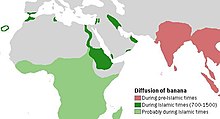Farmers in Southeast Asia and Papua New Guinea first domesticated bananas. Recent archaeological and palaeoenvironmental evidence at Kuk Swamp in the Western Highlands Province of Papua New Guinea suggests that banana cultivation there goes back to at least 5000 BCE, and possibly to 8000 BCE.[4][44] It is likely that other species were later and independently domesticated elsewhere in Southeast Asia. Southeast Asia is the region of primary diversity of the banana. Areas of secondary diversity are found in Africa, indicating a long history of banana cultivation in the region.[45]
Phytolith discoveries in Cameroon dating to the first millennium BCE[47] triggered an as yet unresolved debate about the date of first cultivation in Africa. There is linguistic evidence that bananas were known in Madagascar around that time.[48] The earliest prior evidence indicates that cultivation dates to no earlier than late 6th century CE.[49] It is likely, however, that bananas were brought at least to Madagascar if not to the East African coast during the phase of Malagasy colonization of the island from South East Asia c. 400 CE.[50]
The banana may also have been present in isolated locations elsewhere in the Middle East on the eve of Islam. The spread of Islam was followed by far-reaching diffusion. There are numerous references to it in Islamic texts (such as poems andhadiths) beginning in the 9th century. By the 10th century the banana appears in texts from Palestine and Egypt. From there it diffused into North Africa and Muslim Iberia. During the medieval ages, bananas from Granada were considered among the best in the Arab world.[46] In 650, Islamic conquerors brought the banana to Palestine. Today, banana consumption increases significantly in Islamic countries during Ramadan, the month of daylight fasting.[51]
Bananas were certainly grown in the Christian Kingdom of Cyprus by the late medieval period. Writing in 1458, the Italian traveller and writer Gabriele Capodilista wrote favourably of the extensive farm produce of the estates at Episkopi, near modern-day Limassol, including the region's banana plantations.[52]
Bananas were introduced to the Americas by Portuguese sailors who brought the fruits from West Africa in the 16th century.[53]
Many wild banana species as well as cultivars exist in extraordinary diversity in India, China, and Southeast Asia.

No comments:
Post a Comment